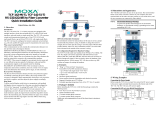
- 2 -
Overview
Introduction
TCF-142 series converters are equipped with a multiple interface circuit
that can handle RS-232, RS-422, and RS-485 serial interfaces, as well as
multi-mode or single-mode fiber. TCF-142 converters are used to extend
serial transmission distance up to 5 km (TCF-142-M, with multi-mode
fiber) or up to 40 km (TCF-142-S, with single-mode fiber). The TCF-142
must be configured to transmit a particular serial interface. You cannot
transmit both RS-232 and RS-485 signals at the same time.
Why Convert Serial to Fiber?
Fiber communication not only extends the communication distance, but
also provides many advantageous features.
IMMUNITY FROM ELECTRICAL INTERFERENCE: Fiber is not affected
by electromagnetic interference or radio frequency interference. It
provides a clean communication path and is immune to cross-talk.
INSULATION: Optical fiber is an insulator; the glass fiber eliminates the
need for using electric currents as the communication medium.
SECURITY: Fiber cannot be tapped by conventional electric means and is
very difficult to tap into optically.
RELIABILITY & MAINTENANCE: Fiber is immune to adverse
temperature and moisture conditions, does not corrode or lose its signal,
and is not affected by short circuits, power surges, or static electricity.
Reverse Power Protection
The Reverse Power Protection feature provides extra protection against
accidentally connecting the power cables to the wrong terminal. The
converter automatically detects which power wire is positive and which is
negative.
Ring Mode
To allow one half-duplex serial device to communicate with multiple
half-duplex devices connected to a fiber ring, you should configure the
TCF-142 for “ring mode” by setting DIP switch “SW4” to the “On” position.
The Tx port of a particular TCF-142 unit connects to the neighboring
converter’s Rx port on the ring. Note that when one node transmits a
signal, the signal travels around the ring until it returns back to the
transmitting unit, which then blocks the signal.
s should ensure that the
total fiber ring length is less
than 100 km
when using
ingle-mode models
TCF-142-S) or multi-mode
odels (TCF-142-M).








